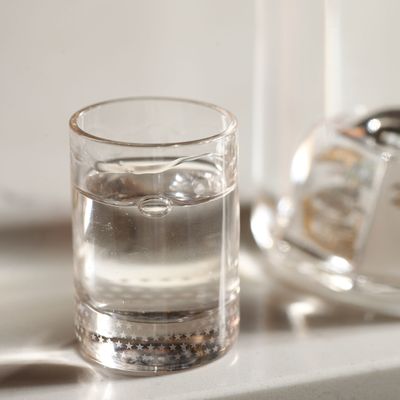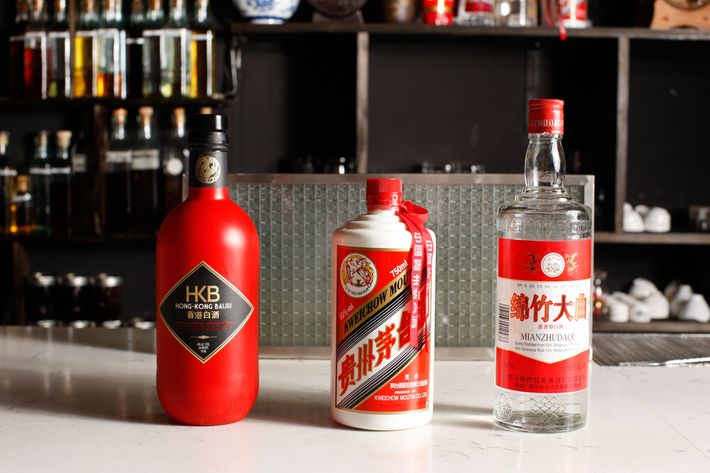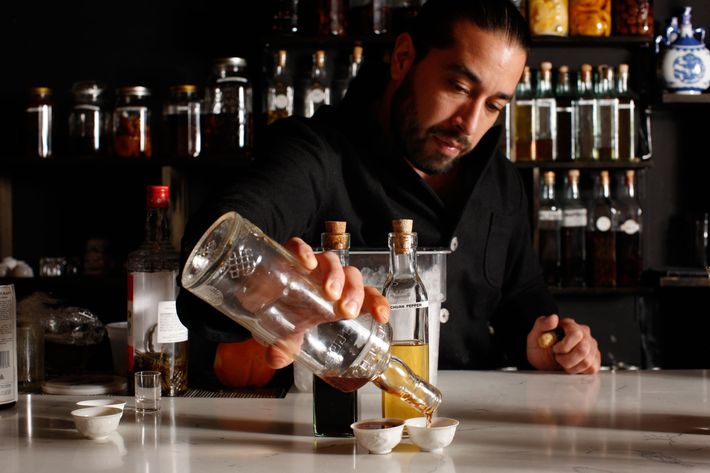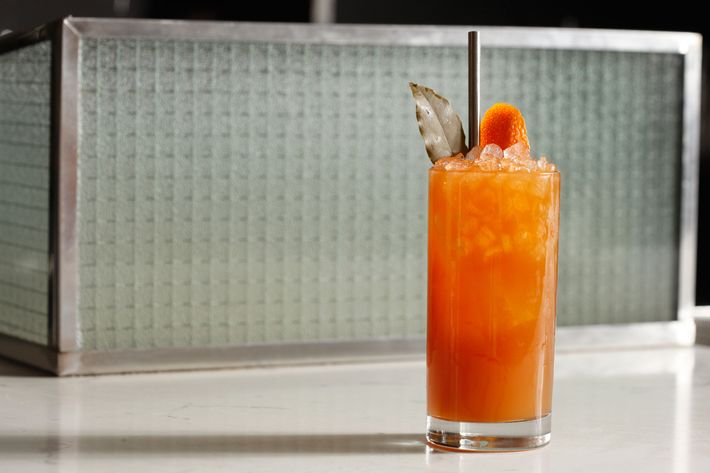
On the stretch of Houston Street between Thompson Street and LaGuardia Place, tucked under a hat store, a four-month-old bar is marked only by a small sign in Chinese: jiǔguǎn, it reads, which translates, approximately, to “bar.” In a town full of faux speakeasies, this might seem otherwise unremarkable until you realize this bar — Lumos — is likely the only one in America that specializes in baijiu, the ancient Chinese liquor that’s probably the most surprising, divisive thing you can drink in the whole city.
Baijiu is rare in the states, though it is available at some cocktail joints around town — usually as a kind of one-off novelty that bartenders stock to impress one another. Though it’s scarce here, baijiu’s billion-strong fan base in China means it’s the best-selling liquor in the world. That it’s failed to gain a foothold in the West is not that surprising, actually, if you’ve talked to Americans who have tried it. The most common flavor descriptors are sweaty socks, or rotten fruit, or things that are even more foul. In other words: To the unaccustomed, this stuff tastes weird.
More generously, you might say it calls to mind the aroma of earthy, smoked pears, and Lumos’s owner, Orson Salicetti — who was formerly the head bartender at Apothéke in Chinatown — opened the bar because he has a romantic fondness for the spirit. “It was a secret,” he says of his first sip. “We all have the experience of traveling somewhere — even just Chinatown or Flushing — and discovering a new fruit, a new spice, so many new flavors.” And now he wants to introduce that flavor (gradually) to the varsity-level drinkers of New York. Here’s what you need to know before you take the plunge.
These are the basics.
In English, baijiu — báijiǔ, technically — is most often pronounced as “bye Joe,” but “bye Gio” is closer. “Bah-joo” works, too. It’s usually distilled from fermented sorghum, though other grains can be used as well. It is also strong. Really strong, running between 80 and 120 proof; this isn’t the kind of thing you drink by the bottle.
There are various baijiu classifications.
Like spirits such as gin and tequila, which have different classes, so does baijiu. Broadly, there are six of them, known as “fragrances,” which indicate the spirit’s flavor: honey fragrance, layered fragrance, light fragrance, rice fragrance, sauce fragrance, and thick fragrance. Western palates tend to favor the lighter and sweeter, but sauce fragrance, which is, admittedly, a tough one to get past for beginners, does pair well with pickled snacks.
You should start gently.
Even Salicetti admits, “This is not a spirit you can just pour into a martini glass and enjoy.” But just as your first beer probably wasn’t a double IPA, your initial sip of baijiu doesn’t have to be the strongest stuff in the bar. In fact, Salicetti designed his menu to work as something of a progression. He suggests starting with one of his cocktails — new additions to the fall menu include a pumpkin drink with rum and a baijiu-spice reduction that tastes like some kind of amazing newfangled pumpkin pie, and another made with fig-infused baijiu and apple cider — before moving to pours of softer baijiu (he says newbies tend to enjoy rice fragrance), and so on.
A night at Lumos probably won’t be cheap.
Lumos’s cocktails start at $15 ($16 for higher-proof drinks), with house-infused baijiu (a dozen flavors, including fig, apple, or basil) going for $12 per shot, or $90 for a nine-ounce bottle. Meanwhile, one-ounce shots of pure baijiu range from $12 to $32. The drinks themselves, though, are spectacularly theatrical creations, in keeping with Salicetti’s run at Apotheke. For a cocktail of goji-infused baijiu and mezcal, which involves a salt-rimmed glass, Salicetti adds absinthe to a bowl of star anise and pink Himalayan rock salt, then lights it all on fire before painting the glass with the molten salt. “We’re not making margaritas,” he jokes.
You’re going to have fun.
You maybe didn’t love things like Laphroaig or Fernet Branca the first time you tried them, either. The trick to appreciating baijiu is embracing its unfamiliar flavor. At Lumos, you will be offered things you’ve never seen, and no matter what you order, you will probably be surprised by it — which is the whole point. When was the last time you drank something truly new at a bar? “Try this!” customers say to their friends after taking a sip of Salicetti’s drinks. “It’s like … ” they’ll start, struggling for a word to describe it. It’s like … It’s like … Well, it’s like something. But don’t worry about it. Instead: More sips. Enjoy.







